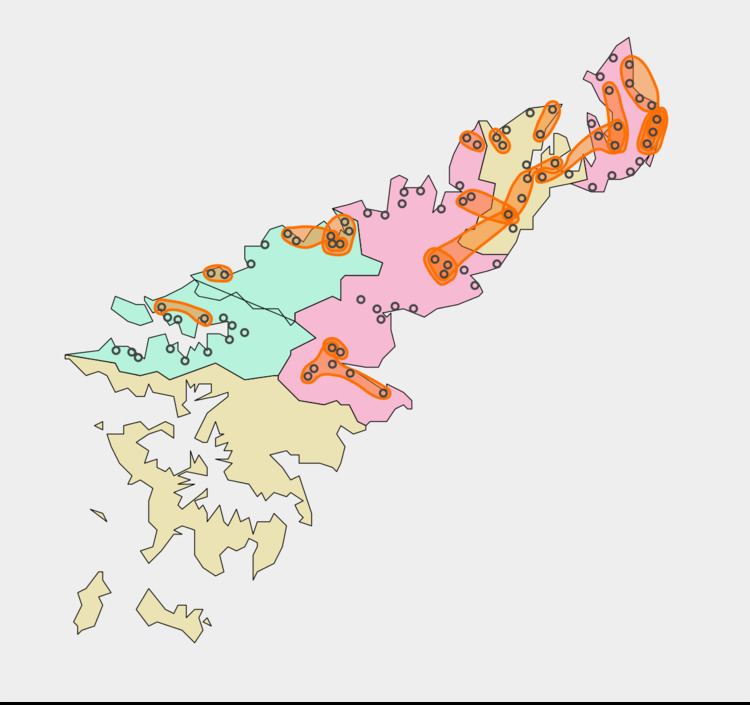Glottolog oshi1235 | Native speakers ca. 12,000 (2004) | |
 | ||
Language family JaponicRyukyuanAmami–OkinawanAmami ISO 639-3 Either:ryn – Northernams – Southern (Setouchi) | ||
The Amami language or languages (Japanese: 島口, シマユムタ, Shimayumuta), also known as Amami Ōshima or simply Ōshima ('Big Island'), is a Ryukyuan language spoken in the Amami Islands south of Kyūshū. The southern variety of Setouchi township may be a distinct language more closely related to Okinawan than it is to northern Ōshima.
Contents
As Amami does not have recognition within Japan as a language, it is officially known as the Amami dialect (奄美方言, Amami Hōgen).
Speakers
The number of competent native speakers is not known, but native speakers are found mostly among old people—as a result of Japanese language policy, the younger generations speak mostly Japanese as their first language. Estimates run around 10,000 for the northern variety and 2,000 for the southern (Setouchi) variety.
Classification
Linguists mostly agree on the validity of the Amami–Okinawan languages as a family. The subdivisions of Amami–Okinawan, however, remain a matter of scholarly debate, with two major hypotheses:
The two-subdivision hypothesis is convenient for discussing the modern languages since the posited linguistic boundary corresponds to the centuries-old administrative boundary that today separates Kagoshima and Okinawa Prefectures. In addition, several isoglosses do group Northern and Southern Amami together. In Amami, word-medial /k/ is changed to /h/ or even dropped when it is surrounded by /a/, /e/ or /o/. This can rarely be observed in Okinawan dialects. Standard Japanese /-awa/ becomes /-oː/ in Amami and /-aː/ in Okinawan.
The three-subdivision hypothesis is more phylogenetically-oriented. A marked isogloss is the vowel systems. Standard Japanese /e/ corresponds to /ɨ/ in Northern Amami Ōshima while it was merged into /i/ in Southern Amami Ōshima through Okinawan.
The vowel system-based classification is not without complication. The northern three communities of Kikai Island share the seven-vowel system with Amami Ōshima and Tokunoshima to the south, while the rest of Kikai falls in with Okinoerabu and Yoron even further south. Based on other evidence, however, Karimata (2000) and Lawrence (2011) tentatively group Kikai dialects together.
Dialects
Amami Ōshima can be divided into Northern Amami Ōshima and Southern Amami Ōshima despite conflicting patterns of isoglosses. The distribution of Southern Amami Ōshima roughly corresponds to Setouchi Town, including offshore islands. The rest of the main island speaks Northern Amami Ōshima.
Shibata et al. (1984) takes a lexicostatistic approach to subgrouping Northern Amami Ōshima dialects:
In addition, Sani, a small community on a peninsula at the northern tip of the island, is known to have distinct phonology.
Based on phonetic and lexical evidence, Shibata et al. (1984) subdivide Southern Amami Ōshima into
reflecting the administrative divisions during the Edo period. While Uke Island belonged to the Nishi Magiri district, its dialect is closer to that of Higashi Magiri.
Southern Amami Ōshima contrasts with Northern Amami Ōshima in its final unreleased consonants. For example, "shrimp" is [ʔip] in Ōshama (Southern) and [ʔibi] in Tatsugō (Northern); "blade" is [katna] in Ōshama and [katana] in Tatsugō.
Names
According to Osada Suma (1902–1998), the dialect of Yamatohama, Yamato Village of Amami Ōshima had yumuta /ˈjumuθa/ for 'language', shimayumuta /simaˈjumuθa/ for 'island language' (i.e. Amami Ōshima) and Yamatoguchi /ˈjamaθoɡuci/ for the language of mainland Japan (i.e. Standard Japanese). Another term, shimaguchi /simaguci/, is absent from Osada's dictionary. According to Kurai Norio (b. 1923), a local historian from Amami Ōshima, shimaguchi contrasted with Yamatoguchi, while shimayumuta was associated with accentual and intonational differences among various shima (villages). Ebara Yoshimori (1905–1988), a folklorist from Naze, Amami Ōshima, conjectured that shimaguchi was of relatively recent origin, possibly made through analogy with Yamatoguchi. He thought that the dialect of one's home community was better referred to as shimayumuta.
Consonants
Historically, vowel-initial words acquired an epenthetic glottal stop. When *wo and *we later became /u/ and /i/ without an initial glottal stop, the glottal stop elsewhere became phonemic. When still later initial consonants were elided, an initial glottal stop merged with the following consonant, establishing a series of "glottalized" consonants. While the nasals are truly glottalized, the "glottalized" stops are merely tenuis [C˭], contrasting with the default aspirated stops [Cʰ].
In the southern Shodon dialect (just off Kakeroma Island), *pʰ has become /ɸ/, and /z/ is only found in recent loans from Japanese.
Closed syllables
In the southern Shodon dialect, the consonants /p t tɕ k ɕ ɾ m n/ occur at the end of a word or syllable, as in /k˭upʰ/ 'neck', /sakʰɾa/ 'cherry blossom' and /t˭ɨɾɡjo/ 'well'. Other dialects are similar. Final consonants are usually the result of eliding high front vowels. Elision is partly conditioned by pitch accent. In Shodon dialect, for example, the noun with accent classes 2.1 and 2.2 are realized as [⎞mɨtʰ] (water, 2.1) and [⎞ʔiʃ] (stone, 2.2) while 2.3-5 nouns retain final vowels, e.g. [mi⎛miː] (ear, 2.3), [ha⎛ɾiː] (needle, 2.4) and [ha⎛ɾuː] (spring, 2.5).
Vowels
There are seven distinct vowel qualities in Amami Ōshima, in addition to a phonemic distinction between long and short vowels and in some dialects oral and nasal vowels.
/ɨ/ and /ɘ/ are generally transcribed "ï" and "ë" in the literature.
/ɨ/ derives from *e and merges with /i/ after alveolar consonants. /ɘ/ mostly derives from a merger of *ae and *ai, and so is usually long. In several northern dialects, the nasal vowels /ã õ ɨ̃ ɘ̃/ developed from the loss of a word-medial /m/:
*pama > pʰaã 'shore', *jome > juw̃ɨ̃ 'bride', *kimo > k˭joõ 'liver', *ɕima > ɕoõ 'island', *mimidzu > mɘɘ̃dza 'earthworm'Kasarisani dialect has 11 oral and nasal vowels, while Sani dialect adds long vowels for a total of 18, the largest inventory of any Ryukyuan dialect.
